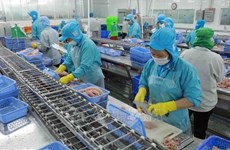FTA to create more rooms for Vietnam-Customs Union cooperation
The signing of a free trade agreement (FTA) between Vietnam and the
Customs Union of Russia, Belarus and Kazakhstan will be an effective
tool for Vietnamese exporters to make inroads into the union boasting a
population of over 170 million with high per capita income.
The signing of a free trade agreement (FTA) between Vietnam and the
Customs Union of Russia, Belarus and Kazakhstan will be an effective
tool for Vietnamese exporters to make inroads into the union boasting a
population of over 170 million with high per capita income.
Minister of Industry and Trade Vu Huy Hoang and Trade Minister of the Eurasian Economic Commission Andrei A.Slepnhev signed a joint statement on the conclusion of the Vietnam-Custom Union Free Trade Agreement (VCUFTA) on December 15 in the southern province of Kien Giang .
Witnessing the event, Prime Minister Nguyen Tan Dung said the signing and implementation of the agreement will be an important progress to enhance bilateral relations in economy, education-training, science-technology, and culture. He urged the two sides to finalise all necessary procedures to put final touches on the agreement in early 2015.
Vietnam and the Custom Unions kicked off their FTA talks in March 2013. After eight rounds of negotiation and many technical discussions, they have initially agreed on contents of the agreement on a wide-ranging scope and high-level commitments while ensuring mutual benefit in line with international practices and regulations of the World Trade Organisation (WTO).
The contents cover trade in goods and services, investment, rules of origin, trade remedy, customs facilitation, technical barriers to trade, sanitary and phytosanitary measures and legal and institutional issues.
Andrei A.Slepnhev, head of the union’s negotiation delegation, said the signing of the pact will boost two-way trade vigorously and promote investment ties among economic members.
From 2015, the Customs Union will be changed into the Eurasian Economic Union with the admission of Armenia and Kyrgyzstan . This will enable Vietnam to become a bridge linking the two economic regions, he said.
Minister Vu Huy Hoang described the union as a promising market. With the VCUFTA, local exports to Russia , Belarus and Kazakhstan could increase by 63 percent, 41 percent and 8 percent, respectively, he said.
The union provides Vietnam with preferential tariffs to facilitate its export of staples such as farm produce, seafood, garments and textiles, footwear and wood furniture.
Meanwhile, Vietnam agrees to open its market under a set roadmap for several commodities from the union, including husbandry products, machines, equipment and vehicles, which will not compete with made-in-Vietnam goods, but help to diversify the domestic market.
Vietnam is the union’s first FTA partner, which will make Vietnamese businesses integrate into the union earlier than others with more preferential conditions. Once the agreement becomes effective, two-way trade is expected to rise by 18-20 percent a year, from 4 billion USD in 2014 to 10-12 billion USD in 2020.-VNA
Minister of Industry and Trade Vu Huy Hoang and Trade Minister of the Eurasian Economic Commission Andrei A.Slepnhev signed a joint statement on the conclusion of the Vietnam-Custom Union Free Trade Agreement (VCUFTA) on December 15 in the southern province of Kien Giang .
Witnessing the event, Prime Minister Nguyen Tan Dung said the signing and implementation of the agreement will be an important progress to enhance bilateral relations in economy, education-training, science-technology, and culture. He urged the two sides to finalise all necessary procedures to put final touches on the agreement in early 2015.
Vietnam and the Custom Unions kicked off their FTA talks in March 2013. After eight rounds of negotiation and many technical discussions, they have initially agreed on contents of the agreement on a wide-ranging scope and high-level commitments while ensuring mutual benefit in line with international practices and regulations of the World Trade Organisation (WTO).
The contents cover trade in goods and services, investment, rules of origin, trade remedy, customs facilitation, technical barriers to trade, sanitary and phytosanitary measures and legal and institutional issues.
Andrei A.Slepnhev, head of the union’s negotiation delegation, said the signing of the pact will boost two-way trade vigorously and promote investment ties among economic members.
From 2015, the Customs Union will be changed into the Eurasian Economic Union with the admission of Armenia and Kyrgyzstan . This will enable Vietnam to become a bridge linking the two economic regions, he said.
Minister Vu Huy Hoang described the union as a promising market. With the VCUFTA, local exports to Russia , Belarus and Kazakhstan could increase by 63 percent, 41 percent and 8 percent, respectively, he said.
The union provides Vietnam with preferential tariffs to facilitate its export of staples such as farm produce, seafood, garments and textiles, footwear and wood furniture.
Meanwhile, Vietnam agrees to open its market under a set roadmap for several commodities from the union, including husbandry products, machines, equipment and vehicles, which will not compete with made-in-Vietnam goods, but help to diversify the domestic market.
Vietnam is the union’s first FTA partner, which will make Vietnamese businesses integrate into the union earlier than others with more preferential conditions. Once the agreement becomes effective, two-way trade is expected to rise by 18-20 percent a year, from 4 billion USD in 2014 to 10-12 billion USD in 2020.-VNA











